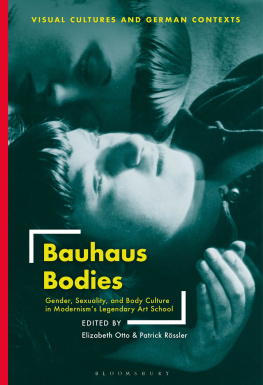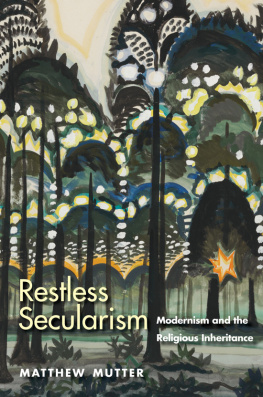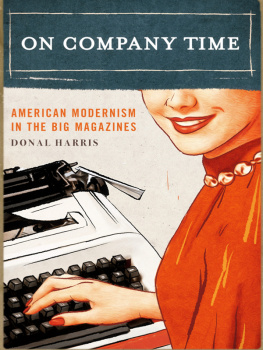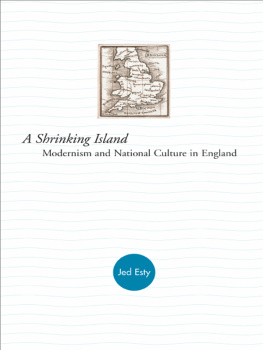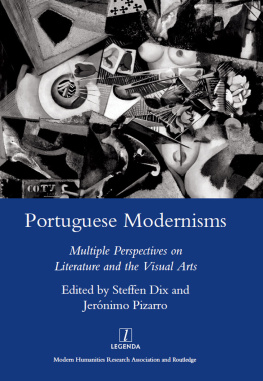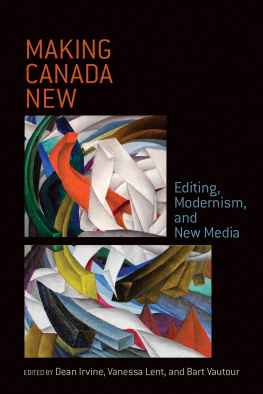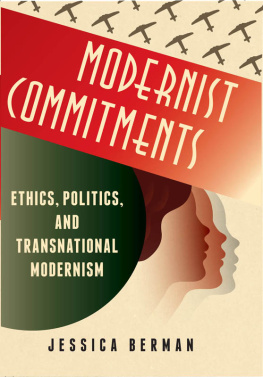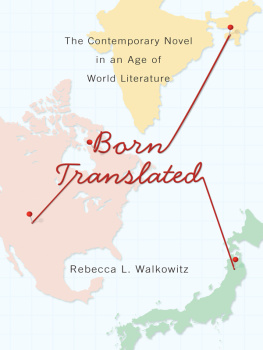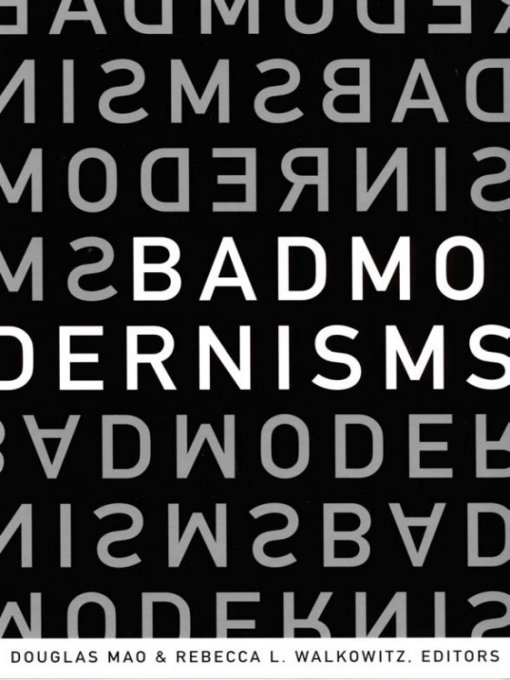
Table of Contents
DUKE UNIVERSITY PRESS DURHAM & LONDON 2006
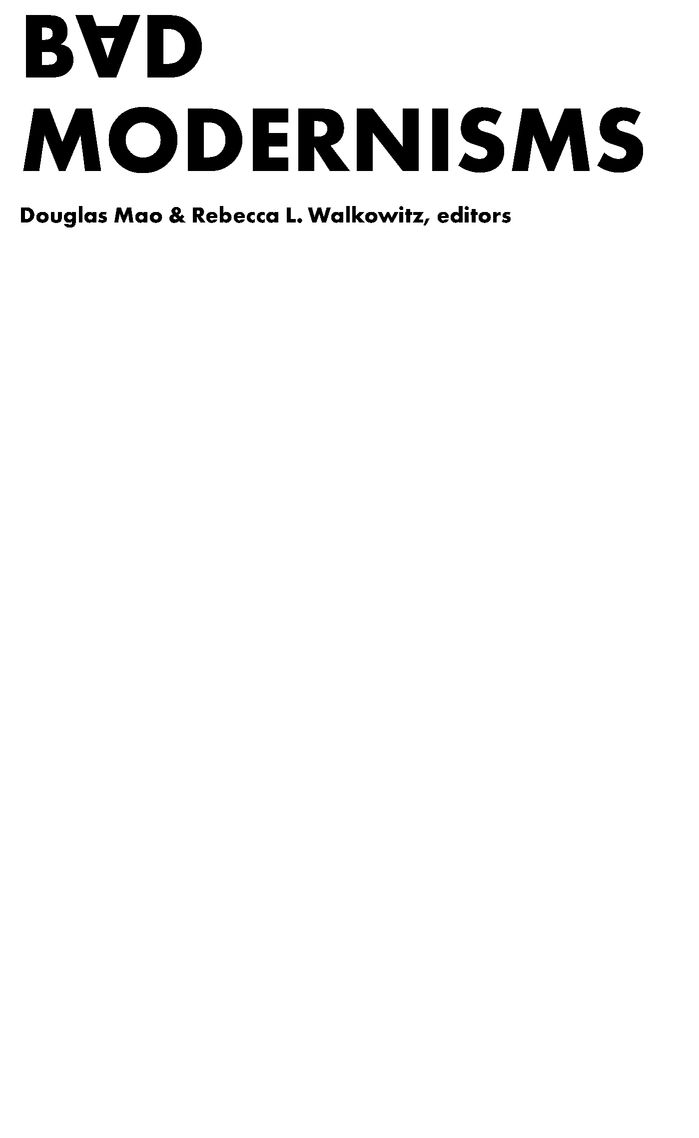
Acknowledgments
The editors take pleasure in thanking the Humanities Center, the Literature Program, and the Department of English at Harvard University for sponsoring the Bad Modernisms conference, which helped to launch this volume. Warm thanks also to Matthew Bremer, who designed the beautiful poster for that event. In the making of Bad Modernisms, we are grateful to Marjorie Garber, Barbara Johnson, Joseph Litvak, Henry S. Turner, Evelyn Schwarz, and Chip Wass for their intellectual generosity and warm support from the beginning and to the anonymous readers for Duke University Press, who made the book better at the end. Finally, our thanks to Taryn Okuma, Sara Phillips, and Christopher Schmitt, who assisted us with the preparation of the manuscript, and to Ken Wissoker, Courtney Berger, Kate Lothman, and Katharine Baker who welcomed and nurtured the volume at Duke.
Douglas Mao and Rebecca L. Walkowitz
Introduction: Modernisms Bad and New
The essays in this volume take up a range of artifacts from poetry and manifestos to philosophy and movie musicals; in so doing, they both exemplify and interrogate the so-called new modernist studies or new modernisms. To be sure, this critical project, whose emergence has coincided with a powerful revival of modernist sensibilities in architecture, design, poetry, and other arts, has not been formulated in any strict or polemical sense by its practitioners. Rather, the new modernisms seem to have arisen from diverse quarters; to have found a stimulus in a new journal (Modernism/Modernity); to have come into focus as the title of a conference (the inaugural meeting of the Modernist Studies Association); and thereafter to have been certified as a coherent trend by a prominent article in the Chronicle of Higher Education. It is clear, nonetheless, that the rubric encompasses at least two significant enterprises: one that reconsiders the definitions, locations, and producers of modernism and another that applies new approaches and methodologies to modernist works.
In its definitional aspect, the new modernist studies has extended the designation modernist beyond such familiar figures as Eliot, Pound, Joyce, and Woolf (to take the subfield of literature in English, central to this volume) and embraced less widely known women writers, authors of mass cultural fiction, makers of the Harlem Renaissance, artists from outside Great Britain and the United States, and other cultural producers hitherto seen as neglecting or resisting modernist innovation. Some contemporary scholars have even chosen to apply modernist yet more globallyto, say, all writing published in the first half of the twentieth centurythereby transforming the term from an evaluative and stylistic designation to a neutral and temporal one, and thus economically countering the implication that a few experimental works were somehow the only ones authentically representative of their age (as in the familiar sequence Romantic-Victorian-Modernist-Postmodernist). The essays in this volume do not replace the qualitative sense of the term with the chronological, however, so much as they ask what happens when the two collide. What effects of synergy or friction result when the many, sometimes contradictory, criteria of high modernism are tested against less evidently experimental texts by principal figures; against principal works by less well known or non-European artists ; against texts that seem neither to be art nor to be about art, such as erotic novels, popular films, spy thrillers, melodrama, and ethnography?
On the side of approaches, the new modernist studies has moved toward a pluralism or fusion of theoretical commitments, as well as a heightened attention to continuities and intersections across the boundaries of artistic media, to collaborations and influences across national and linguistic borders, and (especially) to the relationship between individual works of art and the larger cultures in which they emerged. This direction resonates with developments occurring throughout the humanities in recent years, of course, but it seems to accrue particular influence in the orbit of modernism, because early-twentieth-century writers were themselves so preoccupied with border crossings such as cosmopolitanism, synesthesia, racial masquerade, collage, and translation. In Bad Modernisms, this new variousness of approach is represented by, for example, a comparative reading of European and African American dandyisms, an approach to Filipino American modernism in the context of anti-colonialism, treatments of popular and political works alongside aesthetic treatises and canonical novels, and the commingling of values and techniques from fields such as queer theory, cultural history, cinema studies, anthropology, and literary criticism.
Thus the new modernisms; but why bad modernisms?
Since modernism first became a leading topic of critical disquisition, in the cold war writing of figures like Clement Greenberg, Harry Levin, and Irving Howe, a persistent assumption has been that badness is at once the essence and the Achilles heel of modernist art. The idea that there might be something good about bad artistic behavior did not originate with modernism, but no kind of art, so the early retrospectives suggested, has been more dependent upon a refractory relation between itself and dominant aesthetic values, between itself and its audience, between itself and the bourgeoisie, between itself and capitalism, between itself and mass culture, between itself and society in general. In 1967, for example, Howe led off his list of modernisms signal features by observing that its writers and artists form a kind of permanent ... opposition, ... an avant-garde marked by aggressive defensiveness, extreme self-consciousness, prophetic inclination and the stigmata of alienation.
In offering these generalizations, these critics were drawing upon a century of instigations by artists and reactions from audiences in which bad manners were bound up with bad times, bad feelings, and a radical destabilizing of the criteria by which a work of arts goodness or badness could be judged. The history of the modernist affrontwhose influential purveyors included Baudelaire, Marinetti, and Schoenberg, and whose celebrated events included the New York Armory Show of 1913, the debut of Le sacre du printemps the same year, and the obscenity trials of Ulysses in 1921 and 1933-was shaped by an antagonism to certain all-too-positive elements judged characteristic of works achieving more immediate public acceptance. These elements included uncritical endorsement of traditional forms, I uplifting sentiments and happy endings, complacency about the course of world events, approbation of the social order, and the view that instrumentality and moral legibility were distinguishing features of worthwhile art.
Whether they used the term modernism or not, early-twentieth-century analysts of the new art noted not only its rejection of such positives but also how this mode of social criticism could look more like voluble disdain than visible address. In their 1927 Survey of Modernist Poetry, for example, Laura Riding and Robert Graves tried to show that modern poetrys apparent withdrawal from the plain reader owed much more to that readers timid conventionality (and appetite for Spiritual Elevation) than to any willful obscurantism practiced by poets; in 1931s
Next page



